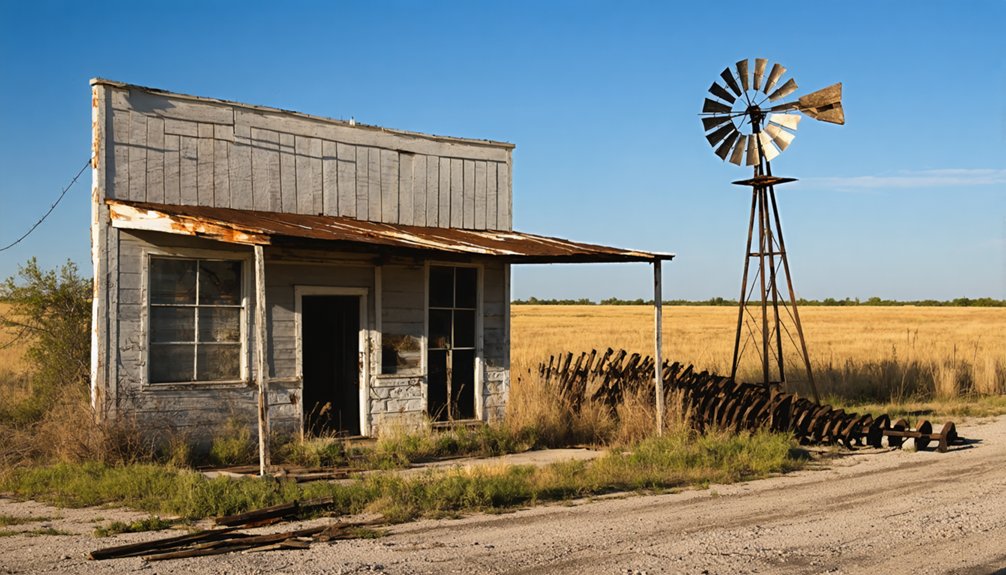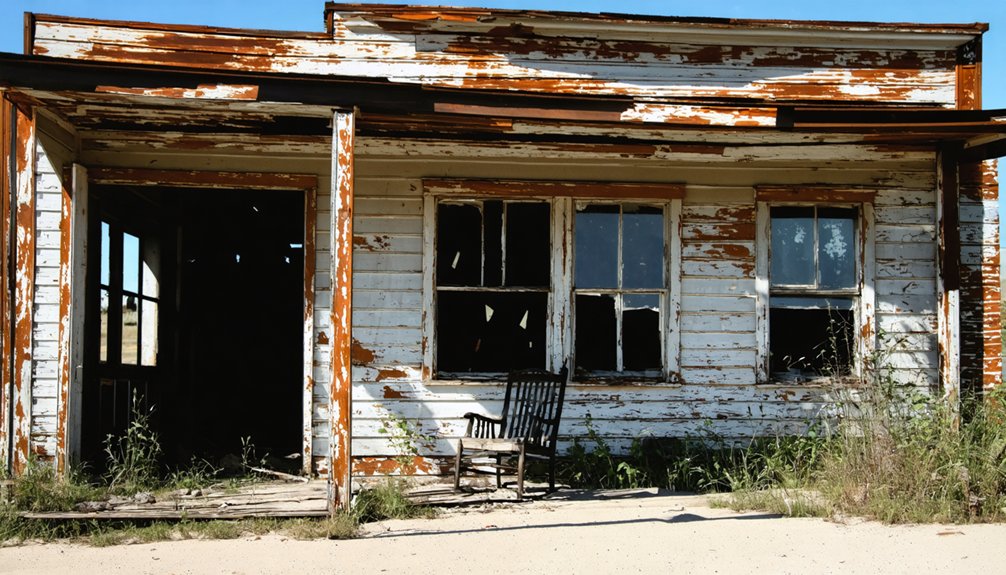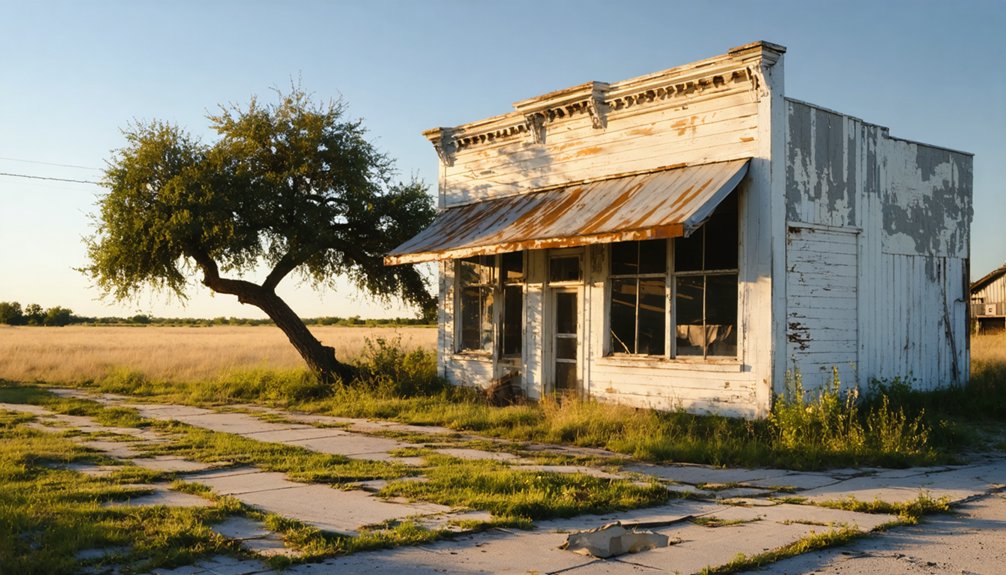You’ll find McGirk nestled in western Hamilton County, where settlers paid $500 in gold for prime sheep ranges in the 1870s. John A. McGirk established the post office in 1882, transforming this Lampasas River settlement into a bustling agricultural hub with a steam-powered cotton gin. The town flourished until World War II drew residents away, leaving only 25 people by 1945. Today, historic maps and cemetery remnants reveal fascinating details about this once-thriving Texas community.
Key Takeaways
- McGirk emerged in western Hamilton County during the 1870s and was named after John A. McGirk, who established the town’s first post office.
- The town’s economy centered around cotton production, with a steam-powered cotton gin serving as the primary economic driver until decline.
- The closure of McGirk’s post office around 1920 marked the beginning of the town’s decline and reduced community interaction.
- World War II accelerated depopulation, leaving only 25 residents by 1945 as people migrated to urban areas for better opportunities.
- Today, only the cemetery remains as physical evidence of McGirk’s existence, making it a documented Texas ghost town.
The Birth of a Texas Settlement
While many Texas settlements emerged in the post-Civil War era, McGirk’s establishment in western Hamilton County during the early 1870s exemplified the strategic placement of frontier communities.
You’ll find the settlement patterns were influenced by the life-giving Lampasas River, which provided crucial resources for early pioneers. Settlers paid hefty sums, often $500 in gold, to secure sheep ranges and farmland in the area. The area required careful name disambiguation between McGirk and similarly named settlements to avoid confusion among travelers and mail carriers.
The region’s natural bounty of timber and native grasses shaped agricultural practices, as newcomers established farms and ranches. Similar to Colonel John McGuirk who became a notable Confederate druggist in Holly Springs, early settlers often brought professional expertise to these frontier communities. They’d construct buildings using local materials, setting up essential infrastructure including a steam-powered cotton gin near the river.
John A. McGirk’s Legacy
Three key contributions cemented John A. McGirk‘s influence on the Texas settlement that bore his name. As the town’s first postmaster in 1882, he established crucial communication networks that connected the community to the wider world.
His leadership helped foster the development of critical infrastructure, including support for the steam-powered cotton gin on the Lampasas River that drove the local economy. Today, many descendants use family history records to trace their connections to early Texas settlers like McGirk.
Like many frontier settlers who built round log cabins using traditional construction methods, McGirk helped establish the town’s first permanent structures.
Finally, his pioneer spirit shaped the community’s early governance and development.
While McGirk, Texas eventually became a ghost town by 1920, you’ll find his legacy preserved in Hamilton County’s historical records and geographic references.
His story exemplifies the determination of 19th-century Texas settlers who carved out communities from the frontier, establishing essential civic institutions that supported agricultural trade and community life.
Peak Years and Community Life
The rhythms of cotton production and agricultural life defined McGirk’s peak years from the 1880s through the early 1900s. You’d have found the steam-powered cotton gin buzzing with activity along the Lampasas River, serving as the economic backbone of this small but essential farming community.
Steam whistles and cotton dust filled McGirk’s air as the gin along the Lampasas River powered the community’s heartbeat.
The community dynamics revolved around the local school and post office, where families gathered and maintained connections to the outside world. Like Best, Texas, the local post office manager would sleep with the cash to protect against theft. The H. W. McGuirk maintained both a store and saloon, which became central gathering spots for the townspeople.
The agricultural significance of McGirk was evident in its strategic location and infrastructure. While you wouldn’t have found grand buildings or extensive commerce, the settlement sustained itself through practical facilities that served local needs.
Farmers brought their cotton to the gin, children attended the schoolhouse, and residents collected their mail from the post office, creating a self-sufficient rural Texas community.
Post Office and Early Commerce
Establishing itself as an essential communication hub, McGirk’s post office opened its doors in 1882 under the leadership of John A. McGirk. For nearly four decades, the post office served as the town’s crucial link to the outside world, facilitating commerce dynamics and connecting residents to regional markets.
You’ll find that McGirk’s early commerce centered around a steam-powered cotton gin built alongside the Lampasas River after 1892. This operation, combined with postal services, created a self-sustaining economic ecosystem. Similar to nearby Mills County towns, McGirk developed strong agricultural roots.
The river’s proximity provided important water power for the gin while enabling transportation of goods, and the post office allowed farmers and merchants to conduct business beyond local boundaries. Together, these elements defined McGirk’s peak period until the post office’s closure around 1920 marked the beginning of the town’s decline. The town’s rich legacy is now preserved through records maintained by dedicated historical organizations.
World War II’s Impact on McGirk
During World War II, McGirk experienced a profound demographic shift that would permanently alter its trajectory as a rural Texas community. By 1945, you’d find only 25 residents remaining in town, as military enlistment and wartime opportunities drew people away.
While Texas’s urban centers and coastal regions flourished with military installations and industrial growth, McGirk’s agricultural economy suffered significant decline. The Port of Corpus Christi diverted much of the region’s transportation and economic activity away from small inland communities.
The economic shifts hit McGirk particularly hard. You’ll notice how the town’s cotton gin and farming operations struggled as workers left for war-related industries elsewhere. Many residents joined the estimated 500,000 Texans who migrated to cities seeking better employment opportunities.
Unlike larger cities with military bases or defense manufacturing, McGirk couldn’t offer the employment opportunities that would keep its population intact.
When veterans returned after 1945, they often bypassed McGirk for promising prospects in Texas’s growing urban centers, accelerating the town’s decline.
The Great Exodus
McGirk’s experience during the Great Exodus mirrors that of many small Texas towns, where you’d find African American families joining the broader migration northward to escape oppressive conditions and seek better opportunities.
You can trace how McGirk’s economy faltered as both Black and white residents left their agricultural roots behind, contributing to the town’s steady decline from its peak of 25 residents in 1945.
When families abandoned their homesteads and farms in McGirk, they followed established migration routes through St. Louis toward promised lands in Kansas and other northern states, leaving behind a diminishing community that would eventually become a ghost town.
Post-War Migration Patterns
As World War II transformed America’s economic and social landscape, a massive demographic shift known as the Second Great Migration (1940-1970) reshaped Texas and the nation.
You’ll find that migration trends followed distinct geographic patterns, with many Texans moving to West Coast cities like Los Angeles and Oakland, while others sought opportunities in Texas’s rapidly expanding urban centers.
The state’s manufacturing sector grew fourfold during this period, sparking unprecedented urban migration.
You’ll notice that these weren’t just rural farmers seeking change – many early migrants were already urban wage laborers.
Defense industries and military installations accelerated this movement, though African Americans still faced workplace discrimination and housing segregation.
Veterans returning from war, often better educated and more determined to access opportunities, fueled both the migration patterns and emerging civil rights activism.
Economic Decline Sparks Flight
While cotton once fueled McGirk’s prosperity, the early 20th century brought devastating economic changes that would ultimately seal the town’s fate. Plummeting cotton prices and increased mechanization stripped farmers of their livelihoods, triggering waves of economic migration as families sought opportunities elsewhere.
The Great Depression delivered the knockout blow, accelerating rural depopulation as residents fled to nearby urban centers.
You’d have witnessed McGirk’s infrastructure crumbling as its tax base evaporated. Key services vanished – hospitals closed, schools shuttered, and businesses folded.
With each departure, the town’s chances of recovery diminished. The few remaining residents faced a harsh reality: without jobs beyond agriculture, and with deteriorating public services, McGirk couldn’t sustain itself.
The town’s dependence on farming left it defenseless against broader economic forces that would transform it into a ghost town.
Family Roots Abandoned
Deep family roots dating back to the 1870s were severed during McGirk’s “Great Exodus” of the mid-20th century.
You’ll find that cherished family traditions and rural identity, once tightly woven into McGirk’s fabric, began unraveling as economic pressures mounted.
The town’s multi-generational households dispersed when the post office closed in 1920, followed by the school’s shutdown in the mid-1930s.
Exploring McGirk’s Remains Today
Today’s visitors to McGirk, Texas will find little more than scattered ruins and overgrown foundations where this small farming community once stood.
If you’re planning ghost town exploration, you’ll need to navigate rural roads to reach this remote site near the Lampasas River. While the remains of a steam-operated cotton gin still exist, most structures have succumbed to decades of abandonment since the last residents left in 1945.
You’ll encounter no tourist amenities or interpretive signs – just the raw remnants of history scattered across private land parcels.
Rural accessibility varies with Central Texas weather conditions, and you’ll need landowner permission before venturing onto the property. The post office and school, closed by the 1930s, have long since crumbled, leaving only traces of McGirk’s brief but notable existence.
Historical Maps and Documents

Through extensive archival research, historians have documented McGirk’s history using at least 13 historic maps, postal records, and land ownership documents that reveal the town’s evolution from the 1870s to its abandonment in 1945.
These records provide essential insights into McGirk’s community identity and development, from its establishment as a bustling agricultural center to its eventual decline.
- You’ll find detailed maps showing homesites, trails, and landmarks, perfect for historic preservation efforts and exploration.
- The post office records (1882-1920) offer a fascinating glimpse into daily life, including postmarks that have become valuable collectibles.
- Land ownership documents and school records trace the town’s transformation from ranch land to settled community, highlighting its agricultural roots and eventual decline.
Notable Landmarks and Structures
When you explore McGirk’s notable landmarks today, you’ll find few remnants of the town’s original structures, though historical records confirm the post office operated from 1882 until its closure by 1920.
The post office, under postmaster John A. McGirk, served as a crucial community center during the town’s peak years, yet no physical traces of the building remain for modern researchers to examine.
While most structural landmarks have vanished, McGirk Cemetery endures as one of the few tangible links to the former settlement’s existence.
Post Office Building History
The establishment of McGirk’s post office in 1882 marked a pivotal moment in the town’s development, with John A. McGirk serving as the first postmaster. This postal infrastructure became the heartbeat of community communication, operating alongside a steam-powered cotton gin that drove the local economy.
- You’ll find no remaining physical evidence of the post office building today, though historical records suggest it was a modest wooden or brick structure.
- The building served as more than just a mail hub – it was your connection to the outside world and a social gathering spot.
By 1920, you’d have witnessed the post office’s closure, signaling McGirk’s gradual decline into ghost town status.
The post office’s legacy lives on through census records and postal registries, telling the story of a once-thriving frontier community that supported Hamilton County’s early development.
McGirk Cemetery Remains
McGirk’s final resting place sits quietly near the abandoned townsite in Hamilton County, a short distance from the Lampasas River’s winding banks.
You’ll find the cemetery reflects the modest means of its pioneer residents, with simple grave marker styles ranging from weathered wooden crosses to stone mounds scattered across the rocky terrain.
Dating to the late 1800s, the cemetery holds the stories of early settlers, miners, and farmers who shaped McGirk’s brief history.
While cemetery preservation remains challenging due to natural weathering and isolation, the site serves as a crucial record of community life before the town’s post-WWII decline.
Many headstones feature folk-art embellishments and personal tokens left by descendants, offering glimpses into the burial customs of rural Central Texas’s frontier era.
McGirk’s Place in Texas History

As a proof of Texas’s post-Civil War expansion, the small settlement of McGirk emerged in western Hamilton County during the early 1870s, establishing itself as one of many rural communities that dotted central Texas’s developing landscape.
McGirk’s cultural significance lies in its representation of rural nostalgia, embodying the spirit of frontier development and agricultural enterprise that characterized the era.
McGirk captures the essence of Texas frontier life, when agriculture and pioneering spirit shaped the cultural identity of rural communities.
- You’ll find McGirk’s story mirrors countless other Texas settlements that flourished briefly before succumbing to urban migration.
- The town’s steam-operated gristmill symbolized the agricultural backbone of early Texas communities.
- Its post office served as a crucial communication hub, connecting isolated farmers to the wider world.
While McGirk’s physical presence has faded, its legacy endures as a reflection of Texas’s dynamic settlement patterns and rural heritage.
Frequently Asked Questions
Are There Any Ghost Stories or Supernatural Legends Associated With Mcgirk?
Like a whisper lost to time, you won’t find documented ghostly encounters or haunted legends tied to McGirk. Historical records and regional archives reveal no supernatural tales from this quiet Texas ghost town.
What Wildlife and Plant Species Can Be Found in Mcgirk Today?
You’ll find grasshoppers, snakes and rodents thriving amid native prairie grasses and scrub brush. Wildlife diversity reflects natural habitat recovery, while plant adaptation allows hardy species to reclaim abandoned structures.
Did Mcgirk Have Any Connection to Native American Settlements or Trails?
Like many Texas settlements, you’ll find McGirk sat near Native American historic trails, particularly those used by Cherokee and Comanche peoples moving through East Texas before European colonization altered these ancient pathways.
What Natural Disasters or Extreme Weather Events Affected Mcgirk’s History?
While you’ll find no record of catastrophic events, McGirk faced typical Central Texas challenges – flood damage near Lampasas River and drought impact on farming contributed to broader economic pressures after WWII.
Are There Any Annual Events or Gatherings Held at Mcgirk’s Former Site?
You’d expect annual celebrations at such a historic site, but there aren’t any community gatherings held at McGirk’s remains today – the town’s been too long abandoned for organized events.
References
- https://www.tshaonline.org/handbook/entries/mcgirk-tx
- https://kids.kiddle.co/McGirk
- https://www.county.org/county-magazine-articles/summer-2025/ghost-towns
- https://www.youtube.com/watch?v=phjUE19A8HM
- https://pastmaps.com/explore/us/texas/hamilton-county/mcgirk/hiking-exploration
- https://en.wikipedia.org/wiki/List_of_ghost_towns_in_Texas
- https://www.texasescapes.com/CentralTexasTownsNorth/McGirk-Texas.htm
- https://www.texasescapes.com/TOWNS/Texas-Ghost-Towns-2-Central-Texas.htm
- https://hillcountryhistory.org/2020/11/19/alicia/
- https://en.wikipedia.org/wiki/McGirk



